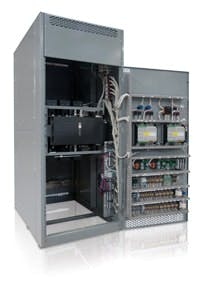Emerson Network Power, a business of Emerson, premieres the ASCO Series 300 Generator Paralleling System — the first transfer switch-based, multi-feature packaged power system with load management for mid-tier installations.
The ASCO Series 300 packaged power system incorporates a reliable, high-endurance ASCO Closed Transition Transfer Switch mechanism that represents a patented and innovative approach to paralleling.The system combines the transfer mechanism with the most sophisticated ASCO load distribution and control technology originally developed for mission-critical, highly-engineered installations. Emerson Network Power scaled the control technology for this standard design, which is available from 208 to 600 volts.
The ASCO Series 300 system can be configured quickly for fast-track delivery because it eliminates job-specific engineering for either prime or emergency power applications that require paralleling two, three or four gen-set installations. It can synchronize, parallel, and provide load sharing fora wide range of gen-sets, of differentsizes and manufacturersusing bias signals to the voltage regulator and governor. This provides needed flexibility to facility managers when they plan power expansions and equipment replacement.
The ASCO Series 300 feature set includes load bus optimization, generator load demand, and generator power metering for controls that satisfy the requirements of distributed data centers, healthcare, commercial and telecom operations, oil and gas processes, and government, agriculture, public and educational facilities.
ASCO Series 300 features that ensure power continuity from automatic controls include manag¬ing generators by runtime usage, assigned priority, or load requirements, and distributing power by load prioritization. The system also can manually add and shed loads, manually start gen-sets and connect to the load bus.
The intuitive operator touch screens provide fingertip access to data and graphics designed to provide monitoring and control with minimal navigation. Screens include metering, event and alarm logs, bus optimization and load demand set up, and manual paralleling. Password protection allows individual account management and auditing as well as privilege assignments.









